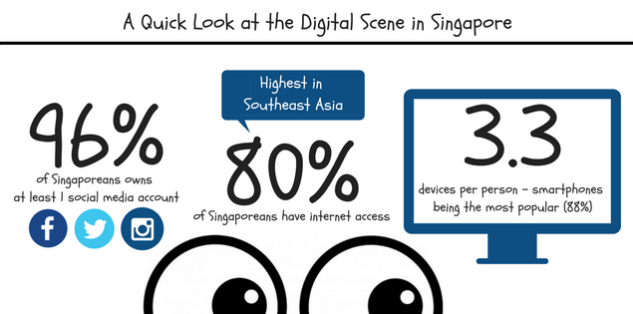Yes, YOU FELL FOR THE CLICKBAIT! How easy was that?! Fake news is popping up everywhere, so how can we evaluate before clicking that ‘Share’ button?
Just like the picture above, there are many sides to 1 story, but which one is the real deal?

Statistics by Digital Influence Lab (Digital Influence Lab, 2015), infographics by me
Having high internet penetration allows us to share the news with just a click of a button, articles gaining a few million engagements is not uncommon these days.
So why is the issue on fake news gaining so much attention? Let’s have a look at the election that took place last year in America!
These outrageous titles were getting more attention than the ‘REAL’ news that was published by the credible news station, some even up to 1 million engagements on Facebook. Imagine being an American citizen, seeing all this on your timeline will sway your views/votes towards both the candidates.
With the filter bubble, Trump supports will only see the negative side of Hillary, vice versa.
Thus, it is critical for us to assess the credibility of the news before hitting the share button.
How does fake news affect Singaporeans?
Statistics by The Straits Time (AU-YONG, 2017), infographics by me
How to spot the real deal?
Using NLB’s SURE initiative that was launched to tackle the rising issue of fake news, we should Source, Understand, Research and Evaluate before making any conclusion.
Library Board (Nlb.gov.sg, 2017), infographics by me
The slideshow presented below evaluates the different methods of assessing credibility. Green = pros. Red = cons.
In conclusion, all approaches has it’s pros and cons thus it is important to evaluate using different methods to obtain a more accurate deduction on the articles/sources.
AND IN CASE YOU’RE STILL WONDERING, I’m NOT pregnant.
(275 words)
References:
Digital Influence Lab. (2015). Singapore Digital Marketing Statistics | Digital Influence Lab. [online] Available at: http://digitalinfluencelab.com/singapore-digital-marketing-stats/ [Accessed 15 Nov. 2017].
AU-YONG, R. (2017). Many Singaporeans concerned about fake news: Poll. [online] The Straits Times. Available at: http://www.straitstimes.com/singapore/many-singaporeans-concerned-about-fake-news-poll [Accessed 15 Nov. 2017].
Nlb.gov.sg. (2017). S.U.R.E. Campaign | National Library Education & Outreach. [online] Available at: http://www.nlb.gov.sg/sure/sure-campaign/ [Accessed 15 Nov. 2017].
Chang, S. (2017). These are the most — and the least — trusted news sources in the U.S. [online] MarketWatch. Available at: https://www.marketwatch.com/story/these-are-the-most-and-the-least-trusted-news-sources-in-the-us-2017-08-03 [Accessed 15 Nov. 2017].
Carr, J. (2015). Why jokes, idioms, and slang are difficult to translate to another language. [online] Janet Carr @. Available at: https://thisbugslife.com/2015/03/10/why-jokes-idioms-and-slang-are-difficult-to-translate-to-another-language/ [Accessed 15 Nov. 2017].
Savchenko, D. (2013). Birds of a feather flock together. [online] Modern-proverbs.blogspot.sg. Available at: http://modern-proverbs.blogspot.sg/2013/03/birds-of-feather-flock-together.html [Accessed 15 Nov. 2017].







